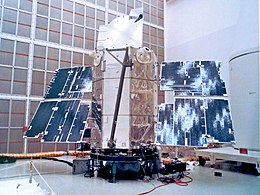


Technicians in a clean room at NASA’s Kennedy Space Center in Cape Canaveral, Florida, check out the Orbiting Astronomical Observatory 2 before the mission’s Dec. 7, 1968, launch.
| |
| Mission type | Astronomy |
|---|---|
| Operator | NASA |
| COSPAR ID | 1968-110A |
| SATCAT no. | 3597 |
| Spacecraft properties | |
| Manufacturer | Grumman |
| Dry mass | 2,012 kilograms (4,436 lb) |
| Start of mission | |
| Launch date | 7 December 1968, 08:40:09 (1968-12-07UTC08:40:09) UTC |
| Rocket | Atlas SLV-3C Centaur-D |
| Launch site | Cape Canaveral LC-36B |
| End of mission | |
| Disposal | Telescope issues |
| Deactivated | February 1973 (1973-03)[1] |
| Orbital parameters | |
| Reference system | Geocentric |
| Regime | Low Earth |
| Perigee altitude | 768 kilometres (477 mi) |
| Apogee altitude | 777 kilometres (483 mi) |
| Inclination | 35.0 degrees |
| Period | 100.30 minutes |
| Epoch | 6 January 1969[2] |
The Orbiting Astronomical Observatory 2 (OAO-2, nicknamed Stargazer) was the first successful space telescope (first space telescope being OAO-1, which failed to operate once in orbit), launched on December 7, 1968.[3]AnAtlas-Centaur rocket launched it into a nearly circular 750-kilometre (470 mi) altitude Earth orbit.[4] Data was collected in ultraviolet on many sources including comets, planets, and galaxies.[3][5] It had two major instrument sets facing in opposite directions; the Smithsonian Astrophysical Observatory (SAO) and the Wisconsin Experiment Package (WEP).[5] One discovery was large halos of hydrogen gas around comets,[5] and it also observed Nova Serpentis, which was a nova discovered in 1970.[3]
The Smithsonian Astrophysical Observatory, also called Celescope, had four 12 inch (30.5 cm) Schwarzschild telescopes that fed into Uvicons.[6] The Uvicon was an ultra-violet light detector based on the Westinghouse Vidicon.[7] Ultraviolet light was converted into electrons which were in turn converted to a voltage as those electrons hit the detection area of the tube.[8] There has been a Uvicon in the collection of the Smithsonian Institution since 1973.[7]
Various filters, photocathodes, and electronics aided in collecting data in several ultraviolet light passbands.[6] The detectors showed a gradual loss of sensitivity[9] and the experiment was turned off in April 1970.[6] By the time it finished about 10 percent of the sky was observed[6] resulting in a catalog of 5,068 UV stars.[9]
The Wisconsin Experiment Package had seven different telescopes for ultraviolet observations.[10] For example, there was a nebular photoelectric photometer fed by a 16-inch (40.64 cm) telescope with a six-position filter wheel[10] that unfortunately failed a few weeks after launch.[9]
Construction was supervised by Arthur Code of the University of Wisconsin-Madison. [9] WEP observed over 1200 targets in ultraviolet light before the mission ended in early 1973.[5]
In addition to the Celescope's catalog of UV stars, the WEP observed comet Tago-Sato-Kosaka and found it to be surrounded by a cloud of hydrogen, confirming that the comet was largely made up of water, and detected the 2175-angstrom bump, an increase in UV absorption at that wavelength that is still not fully explained.[9]
The observatory was built in the shape of an octagonal prism. It measured about 10 by 7 ft (3.0 by 2.1 m) and weighed 4,400 lb (2,000 kg).[11]
|
| |||||||||||||
|---|---|---|---|---|---|---|---|---|---|---|---|---|---|
| Operating |
| ||||||||||||
| Planned |
| ||||||||||||
| Proposed |
| ||||||||||||
| Retired |
| ||||||||||||
| Hibernating (Mission completed) |
| ||||||||||||
| Lost/Failed |
| ||||||||||||
| Cancelled |
| ||||||||||||
| Related |
| ||||||||||||
| |||||||||||||
This article about a specific observatory, telescope or astronomical instrument is a stub. You can help Wikipedia by expanding it. |
This article about one or more spacecraft of the United States is a stub. You can help Wikipedia by expanding it. |